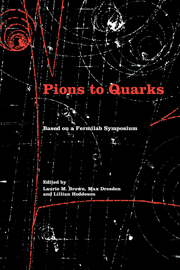Book contents
- Frontmatter
- Contents
- List of contributors
- Foreword by Leon M. Lederman
- Editors' acknowledgments
- Photographs of the symposium
- List of abbreviations
- List of notation
- I Introduction
- II Particle discoveries in cosmic rays
- III High-energy nuclear physics
- IV The new laboratory
- V The strange particles
- VI Weak interactions
- VII Weak interactions and parity nonconservation
- VIII The particle physics community
- IX Theories of hadrons
- 39 The early S-matrix theory and its propagation (1942–1952)
- 40 From field theory to phenomenology: the history of dispersion relations
- 41 Particles as S-matrix poles: hadron democracy
- 42 The general theory of quantized fields in the 1950s
- 43 The classification and structure of hadrons
- 44 Gauge principle, vector-meson dominance, and spontaneous symmetry breaking
- X Personal overviews
- Name index
- Subject index
44 - Gauge principle, vector-meson dominance, and spontaneous symmetry breaking
Published online by Cambridge University Press: 07 May 2010
- Frontmatter
- Contents
- List of contributors
- Foreword by Leon M. Lederman
- Editors' acknowledgments
- Photographs of the symposium
- List of abbreviations
- List of notation
- I Introduction
- II Particle discoveries in cosmic rays
- III High-energy nuclear physics
- IV The new laboratory
- V The strange particles
- VI Weak interactions
- VII Weak interactions and parity nonconservation
- VIII The particle physics community
- IX Theories of hadrons
- 39 The early S-matrix theory and its propagation (1942–1952)
- 40 From field theory to phenomenology: the history of dispersion relations
- 41 Particles as S-matrix poles: hadron democracy
- 42 The general theory of quantized fields in the 1950s
- 43 The classification and structure of hadrons
- 44 Gauge principle, vector-meson dominance, and spontaneous symmetry breaking
- X Personal overviews
- Name index
- Subject index
Summary
With the benefit of hindsight, I would like to speak on certain theoretical developments that occurred during the late 1950s. The subject matter I shall discuss centers around the views regarding the meaning and role of symmetries, or the lack thereof. I shall talk in particular about the happenings in Chicago, not only because they are what I experienced at first hand but also because one of the participants, Jun John Sakurai, unfortunately cannot be heard any more. Let me begin by stating that, at the risk of oversimplification, I regard Ernest Lawrence and Hideki Yukawa as the two founding fathers of particle physics, in that they respectively established the basic experimental and theoretical methodologies in this field. That these are the basic methodologies still holds true, with some qualifications that I shall come to in a moment.
Limiting myself to the theoretical side only, Yukawa's way was to freely invent (or postulate) new particles in order to explain phenomena that are new or not yet understood. Although Yukawa stopped pursuing this direction after his success with the meson theory, the philosophy behind it was articulated and practiced by his collaborator Shoichi Sakata, yielding further successes. The two-meson theory was one such example. At any rate, Yukawa's approach was phenomenological and ad hoc, in that it lacked a theoretical guiding principle of its own, which was perhaps the reason why he stopped pursuing it. This contrasts with the current situation in which gauge theory has established itself as the supreme principle.
- Type
- Chapter
- Information
- Pions to QuarksParticle Physics in the 1950s, pp. 639 - 642Publisher: Cambridge University PressPrint publication year: 1989
- 2
- Cited by



